MINIMALISM AND SHOPPING: HOW TO SHOP WITH INTENTION
Wanting to embrace a clutter-free minimalist lifestyle but looking for some tips on how to shop more mindfully? Here are some tips on minimalism and shopping and 18 ways to shop with intention.
FOR THE LOVE OF SHOPPING
We have a new gift shop in our local town. It’s full of pretty things to make your home and life more beautiful.
Home décor, fashion accessories, stationery, books, photo frames, scented candles, cards, jewellery, bath, beauty and perfume products plus so much more! All beautifully displayed in the shop window, which teases and pulls you in, to the gorgeous shelves upon shelves of little treasures and delights that bring warmth and happiness to your heart and mind.
I wandered in there with my daughter on a cold, rainy afternoon, in search of some feel-good vibes after a tough day at work. I was curious to see what’s in this welcoming, cosy boutique little shop. After 20 minutes of browsing, I came away having bought nothing but desperately wanting everything!
You see, even as a minimalist who loves simple, clutter-free spaces and chats about making wise, intentional decisions, I too can get sorely tempted!
The lure of the shops, the emotional high and thrill of finding something new (better still, at a bargain), can affect so many of us. And it’s really tough to say no. I get it!
Marketing is big business and everywhere we look, modern life encourages us to buy MORE, buy BIGGER, buy the BEST.
SHOPPING HABITS
The shops are experts in encouraging us to spend and buy more. From the advertising in the windows, to the layout of the stores, even to the height and position of the display stands. It’s science and big business. But, it’s not just the stores and advertising companies that encourage us to shop.
We shop for other reasons too. Maybe you shop because:
- You’re bored or it’s something to do on a rainy weekend. Shopping can be a fun way to spend your leisure time.
- You’re struggling financially and snapping up a bargain is how you buy things you really need.
- You were taught to measure success and fulfilment in life by the value and quantity of your material possessions.
- It’s a way to escape from, wind down or numb difficult emotions and circumstances. The thrill and distraction of shopping masks other emotions.
- It’s become your default response to challenges in life and it’s time to reconsider your spending and shopping habits.
We shop for lots of different reasons and I think it’s always helpful to understand our own shopping habits and motivations. And, there’s no shame or judgement here. We all have issues we need to address in some way but if you struggle with difficult shopping habits, or just want to learn how to shop more intentionally, I hope this article helps.
MINIMALISM AND INTENTIONALITY
Minimalism is a lifestyle choice encouraging us to clear the clutter from our home, schedule, mind and life and intentionally make space and time for the things that matter most to us. Whilst the minimalist lifestyle is about being conscious and aware of what we keep in and what we let go of, many people take their first steps by decluttering their homes and getting rid of stuff that’s no longer wanted, needed, used or loved.
Minimalism is not just about our stuff, it’s about our values and priorities and being mindful of our choices, actions and decisions in every aspect of life, from what’s in our homes, to what clutters our schedule, takes up bandwidth in our brains and so much more besides.
Minimalism has many wonderful benefits, including a calmer, more peaceful home, more time for love, laughter and learning, better money management and less stress and overwhelm. There’s a lot to love about embracing minimalism in your own life.
If a clutter-free, intentional life and its benefits speaks to you, in this article I’m sharing some thoughts around minimalism and shopping and a few tips on how to shop like a minimalist.
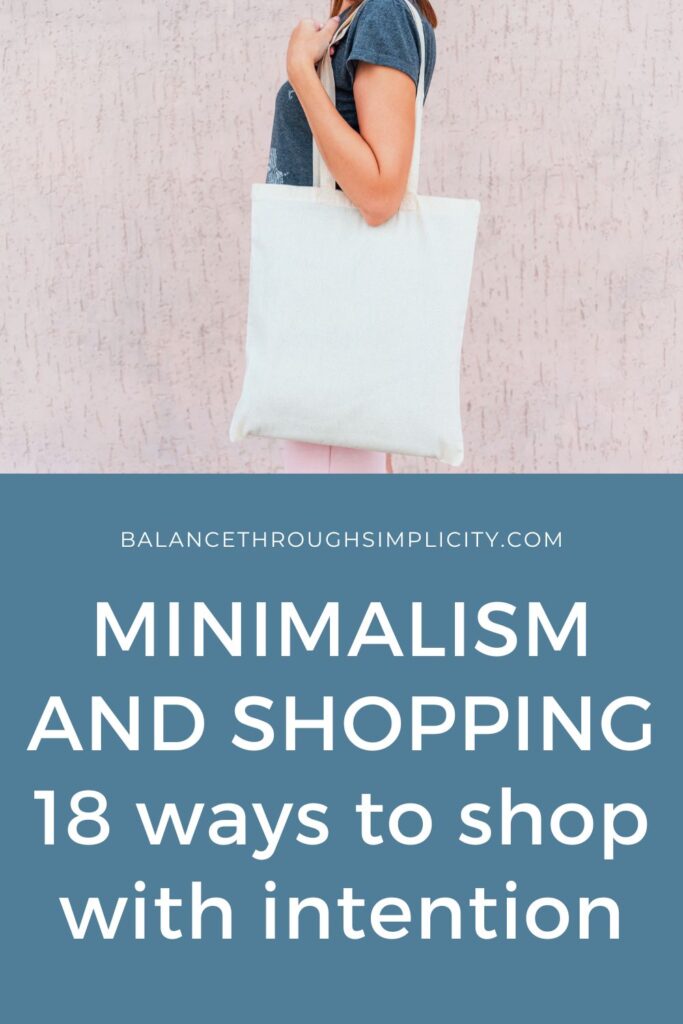
MINDFUL AND INTENTIONAL SHOPPING
We all need to go shopping because things run out, run low or run down. Shopping is also fun and it’s lovely to have new items to look at, use or wear. Living by minimalist principles certainly doesn’t mean you won’t or can’t go shopping as that wouldn’t be very practical, sustainable or realistic!
However, here are some points that you might find helpful on how to shop like a minimalist if you’re looking to shop more mindfully and intentionally.
1. Minimalism doesn’t mean you can’t go shopping
Minimalism encourages awareness and purpose but it definitely doesn’t mean you can’t buy new things. Instead, shopping like a minimalist just means you make better purchasing decisions. You think carefully about whether what you’re buying will add value to your life in some way or will today’s purchase just become tomorrow’s clutter and drain on your bank account. Plenty of minimalists love to shop but the key takeaway is this – the way in which they shop is different. You’ll read more about that soon…
2. Minimalism doesn’t always mean you’ll spend less
Whilst there are parallels between minimalism and frugal living, I don’t think I spend much, if any, less money as a minimalist than I did before. But, the big difference is where I spend my money. I no longer buy so much ‘stuff’ and physical items that need looking after, instead I buy experiences, skills and memories. Days out with the kids, dinners in restaurants, online courses and so on. Minimalism can help you save money though if that’s your goal. As Francine Jay says, “Minimalism is about asking why before you buy.”
3. Minimalism requires a focus on priorities
One of the biggest lessons from minimalism that changed my life was encouraging me to think about my priorities. What’s most important to me, what REALLY matters to me. Knowing this about myself helps me shop better.
To give you an example, I could buy a really cute set of candles for my living room from that little boutique shop I told you about earlier, but I know that I’d have to move and dust them. Besides, I have plenty of candles (sitting in a cupboard) so I don’t need any more. When I do have them out, I usually forget to light them anyway! Although the candles look pretty, I don’t need them and when I really think about it, I kind of prefer my living room to be clutter-free, easy to tidy and visually calm.
If I bought this set of candles, what’s to say I wouldn’t then talk myself into buying something else that was equally cute! Instead of saying yes to the candles, I said yes to sticking with my clutter-free home instead. And, in the end, it was an easy decision because it was based on my priorities.
4. Minimalist shopping get easier with practice
With the list of minimalist shopping tips I’m sharing in this article, it might feel overwhelming and too much to think about when you’re caught up in the hype and excitement of bargain-hunting, sales and stores galore. But, I did find that shopping like a minimalist gets easier with practice.
The more I intentionally decided to buy less and buy wiser, the more I practiced my mindful shopping muscles. I got better at working out if I really wanted/needed something, better at sticking with a list, stronger at saying no to myself and more likely to seek out happiness and contentment in other ways rather than hitting the shops. Shopping like a minimalist gets easier with practice.
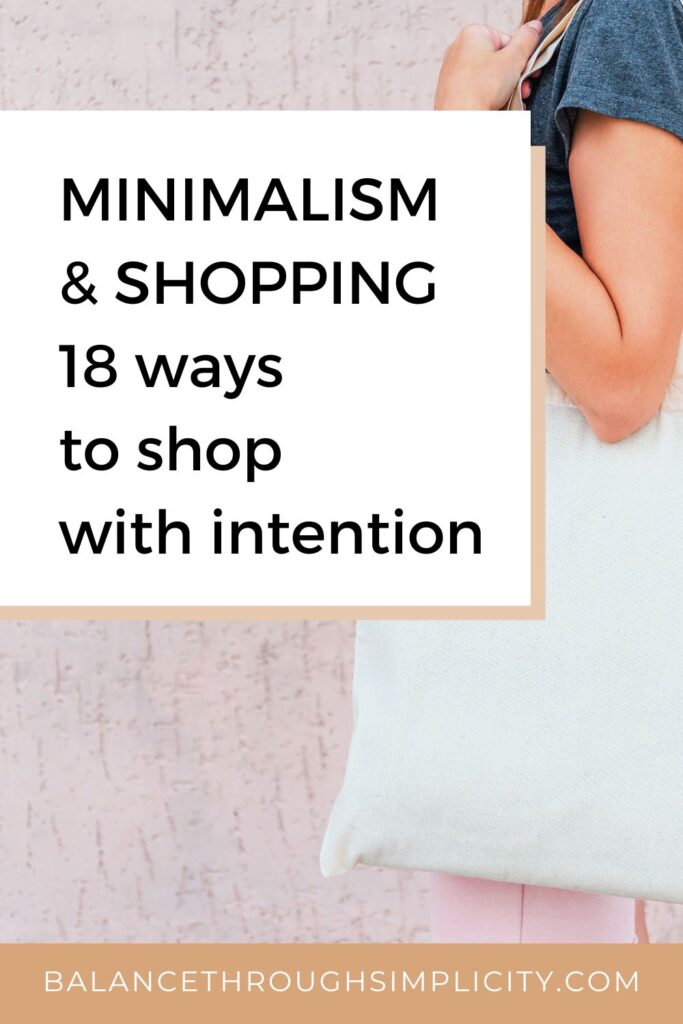
18 WAYS TO SHOP WITH INTENTION
Below you’ll find 18 ways to shop with intention. Here are some practical tips on how to shop like a minimalist and shop more mindfully, asking why before you buy.
1. Mindset
Firstly, you need to get into the minimalist mindset. Remember that minimalism and simple living is not about living in scarcity but instead encouraging you to focus on what’s really important. Every time you go to the shops and think about buying something, ask yourself if what you’re buying is adding value to and enhancing your life or whether it’s a quick fix to make you temporarily feel good. Will it ultimately just add to the clutter in your home or your list of things to do and think about?
2. Ask yourself some questions
Ask yourself some questions whenever you’re about to buy something – do I really need it, do I really love it, do I have something similar that I could use instead, what would happen if I didn’t buy it and is it really worth spending my money and time buying it? The answer should be YES! YES! YES! If not, don’t buy it now, sit and mull the decision over. You can read more about these questions further down this article.
3. Use a shopping list
Always go armed with a list of what you want to buy. I find it easier to follow the list, tick it off as I go and it’s a helpful limitation or boundary to think to yourself – if it’s not on the list, don’t buy it. In a way, the list makes your shopping decision more objective and practical rather than relying on your emotions and willpower to do the deciding for you.
4. Set your budget
Set your budget before you go or only take with you a certain amount of cash, so you don’t get carried away. Leave those credit cards at home so you’re not tempted to spend more than you can afford. Again, this is another way to set a limit or boundary to define your purchasing.
5. Stay away from sales
Avoid sale time unless you’re confident that you won’t get swayed by the amazing discounts. It’s amazing how much we can justify our purchases when we really want to buy something. If money is a struggle and you rely on discounted and bargain items for your shopping, then maybe still take a well thought-out list and stick with a budget. As they say, “it’s not a bargain if you weren’t going to buy it anyway”!
6. Don’t go alone
Take someone with you who you trust. Make sure they know to tell you when to stop if you get carried away! You might also find this helpful to chat through your thoughts before you make a purchase. Why do you want to buy the item? What function or purpose will it have? Do you really need it long term? Your friend or loved one might remind you of when you bought something similar previously and it ended up in a cupboard, or they may suggest you already have something you could use instead, or borrow or rent it.
7. Think first
Never buy something on a whim! Take a moment to reflect on whether you really need that item before you commit to buying it. Pause, take a breath, consider the longer-term implications, focus on your priorities. Shopping intentionally is about making purchasing decisions with your head and thoughts, not just your heart and emotions.
8. The one in/one out rule
If you can’t resist something you see in the shop but which you don’t strictly need, then consider the ‘one in/one out’ rule. Could you buy that item but then get rid of, or donate, something that you’ve already got so you don’t end up accumulating yet more? Use this approach with caution though as it’s also a trap which can lull you into a false sense of security. It’s not to give you permission and a way out to just keep shopping!
9. Sit with the idea
If you see something in the shop that you really like and want to buy, then ask the shop if it’s something you can buy online from their website. Go home, sit with the idea for a few days and if you still really want the item, then buy it online. This avoids buying things on a whim and makes you really consider the purchase. Or, you could even just go for a coffee and think through your intended purchase before you make it.
10. Time yourself
Set the timer on your phone for a set period of time. Stop shopping when the timer goes off!
11. Shop online
When I do the food shopping I tend to do this online. I find I get distracted less by all the sales and marketing tactics of discounted prices and special offers and I stick to my list better. The kids also don’t get the chance to sneak anything into my shopping basket or trolley without me knowing (until we reach the check out!). Online shopping comes with its own set of pros and cons, so again, use this tip with caution. Avoid browsing shopping sites when you’re feeling down or upset and you’re less likely to resist the temptation of clicking that ‘buy now’ button.
12. Shop local and independent
Shopping centres and big stores are like goldfish bowls. They make you walk round and round, tempting you into each and every shop or department as you go around in circles trying to find the exit or the one item you came for in the first place. There’s advertising everywhere to suck you into buying things you hadn’t planned and probably don’t need. Stick to smaller individual shops, support local wherever you can and you’re much more likely to buy only what you intended.
13. Don’t stockpile
Don’t fall into the trap of buying five bottles of shampoo because they were on special offer. Use up what you already have before you buy new. If you’re running low, pop it on the shopping list to get just one replacement next time you’re shopping. If money is tight, you might need to take advantage of special offers, but take a mindful and sensible approach. Don’t buy duplicates of items you haven’t tried before, or don’t use often enough to justify managing the inventory of that item before you use it up.
14. Avoid duplication
If you spot something you like, think about whether you already have something similar and do you like this new one more than your existing? If you’ve got the budget, by all means buy it, but then donate or throw away the old one. Do you really need two!
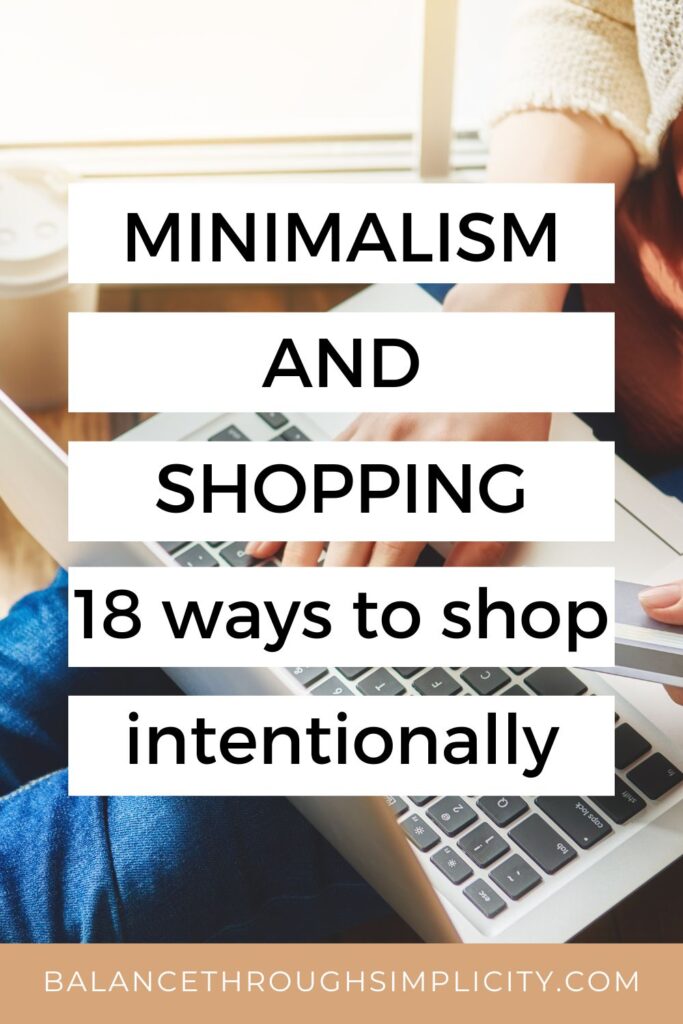
SHOPPING FOR CLOTHES (WITH INTENTION!)
Here are some extra tips to bear in mind when shopping for clothes so you can avoid buying clothes you don’t need.
15. Prioritise
Set yourself a budget and just buy one or two pieces a month or whatever your budget allows. If you’re looking to revamp your whole wardrobe for a new season or a new activity, for example, going back to work after having children, then work out what your priority items are and look for those first. For more help with this, here are some tips on how to purge your closet quickly and assess what you have already.
16. Quality over quantity
Invest in quality key pieces that are wardrobe staples. Maybe consider spending a bit more on these items if your budget allows as they will last for longer.
17. Go cheaper for in-season items
Go for brands that are more reasonably priced for current or seasonal clothes so it doesn’t matter so much if they only last a season or two.
18. Versatility
Look for items that are easy care, don’t need dry cleaning and ironing and are versatile enough to be dressed up or down and go with lots of other things in your wardrobe. Read this post for other tips on curating a simple wardrobe.
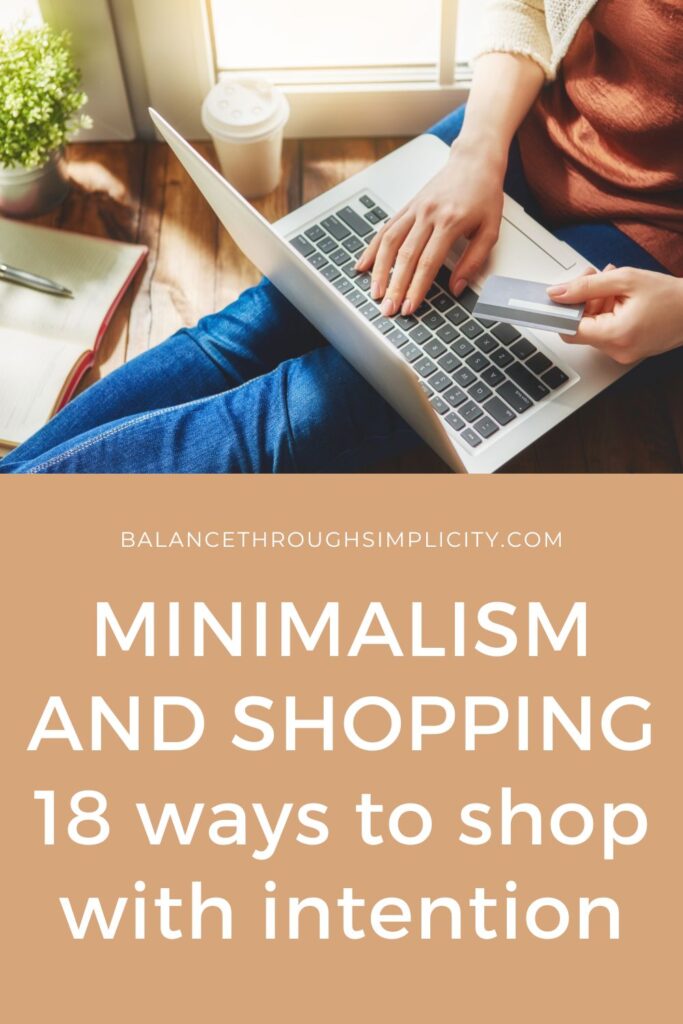
HOW TO SHOP LIKE A MINIMALIST
Next time you go shopping, try to remember these points and see if it makes a difference!
Remember that minimalism isn’t about trying to live with as little as possible or not doing things that make you happy.
Saying that you can’t ever go shopping, buy new things and have fun doing it, is NOT what the minimalist life is about.
Shopping like a minimalist is about shopping intentionally and mindfully. It is about being aware of how and why you’re spending your money to buy something and whether what you’re buying is going to truly enhance your life in some way. How you define that is very personal but you have to be really honest with yourself!
“Minimalism is asking why before you buy.”
Francine Jay
Minimalism and shopping isn’t a precise science. We’ve all bought something that was totally pointless, we didn’t need or we didn’t really think through, just because we loved it, wanted it and had to have it! Sometimes there’s a lot to be said for doing things on a whim and having fun along the way.
However, what the minimalist lifestyle does encourage you to do is to re-think old habits and redefine your priorities. Over time, you might find other ways of honouring these instead of hitting the shops. And, if you do, remember these little tips for more mindful shopping!
QUESTIONS TO ASK YOURSELF BEFORE SHOPPING
Armed with these minimalist shopping strategies, I hope you find it easier to make purchases more wisely and avoid bringing more stuff into your home.
One other suggestion that has really helped me shop more mindfully, is to ask myself some questions before I start shopping.
These questions and the answers that come forward encourage me to think carefully about what I’m buying and why I’m buying it.
1. Do you have this item already?
Avoid duplicates where possible. If you’ve got a similar item already, do you really need another?
2. Do you have something similar already?
It may not be the perfect option, but if you’ve got something that’s good enough, will do the job and is pretty much the same, can you use it instead of buying new?
3. When will you use it?
How many times will you use the item after you’ve purchased it? Once or twice but then no more? Is this a good way to spend your money or contribute stuff to your home? Will you use it regularly? Is it fully versatile and/or functional?
4. Can you loan or borrow the item or find it for free?
Perhaps you don’t need to buy the item outright. Could you borrow a book from the library or that camping equipment from your neighbour, or that handbag from your friend? Check out Freecycle, Facebook Marketplace or your local donation centres.
5. Where will you keep this item?
If you don’t have a home for the item when you’re not using it, then it’s likely to be stuffed in a random cupboard or left on a table top! If you don’t have a place to store it, are you going to be frustrated with looking at, moving and clearing it? Will this frustration outweigh the benefit of buying the item in the first place?!
SHARE YOUR THOUGHTS
I hope these little questions give you some things to think about before you go shopping. As the quote from Francine Jay goes, “Minimalism is asking why before you buy.”
Minimalism isn’t about never going shopping, enjoying something new, spending money or treating yourself. Shopping like a minimalist is just about asking questions and adopting healthy shopping habits to ensure we’re adding value to our lives in some way, instead of draining our bank accounts and cluttering up our spaces in the process.
I hope the ideas in this article help you get clear on how your shopping habits can add value to your life and why.
What are your shopping habits like? Do you struggle with over-spending or buying things you don’t need? Do you have any other tips to share that might help others shop more intentionally and aware? I’d love to hear from you so please leave a comment below.
RESOURCES FOR MINIMALIST LIVING
If you’d like to explore what a minimalist lifestyle could mean for you, here are some resources which you might find helpful:
- What is Minimalism and a Few Things It’s Not – Minimalism is a lifestyle that enables you to focus on what matters. In this article I’m exploring what is minimalism and a few things it’s not. I hope it encourages you to approach minimalism with an open mind and explore it for yourself if you’d like to!
- How to Stop Buying Clothes You Don’t Need – Struggling to break a difficult shopping habit or spending too much money and later regretting your purchase? Here are some helpful tips on how to stop buying clothes you don’t need.
- 14 Amazing Benefits of a Capsule Wardrobe – Capsule wardrobes have become increasingly popular. In this article I share 14 amazing benefits of a capsule wardrobe to help simplify your life, enjoy and make the most of your clothes. There’s also a free printable Wardrobe Declutter Checklist to get you started!
- How to Stop Impulse Buying and Purchase More Intentionally – Do you struggle with overspending and impulse buying? Are you a shopaholic and having difficulty curbing your shopping habits? Do you love the sales and can’t resist a bargain? Here are some tips on how to stop impulse buying and purchase more intentionally.
- Declutter Starter Kit – a free guide and workbook to help you understand the what, why and how of decluttering. Projects, tips and guidance to clear the clutter in your home and life.
DON’T MISS OUT!
I’m Antonia and on this blog I share practical inspiration to simplify your home, time and life. Follow me on Instagram, Facebook and Pinterest! You can also subscribe to Balance Through Simplicity and receive regular simplicity tips straight to your inbox for free. Make sure you never miss an article plus you’ll get a copy of my free Declutter Starter Kit as a welcome gift!

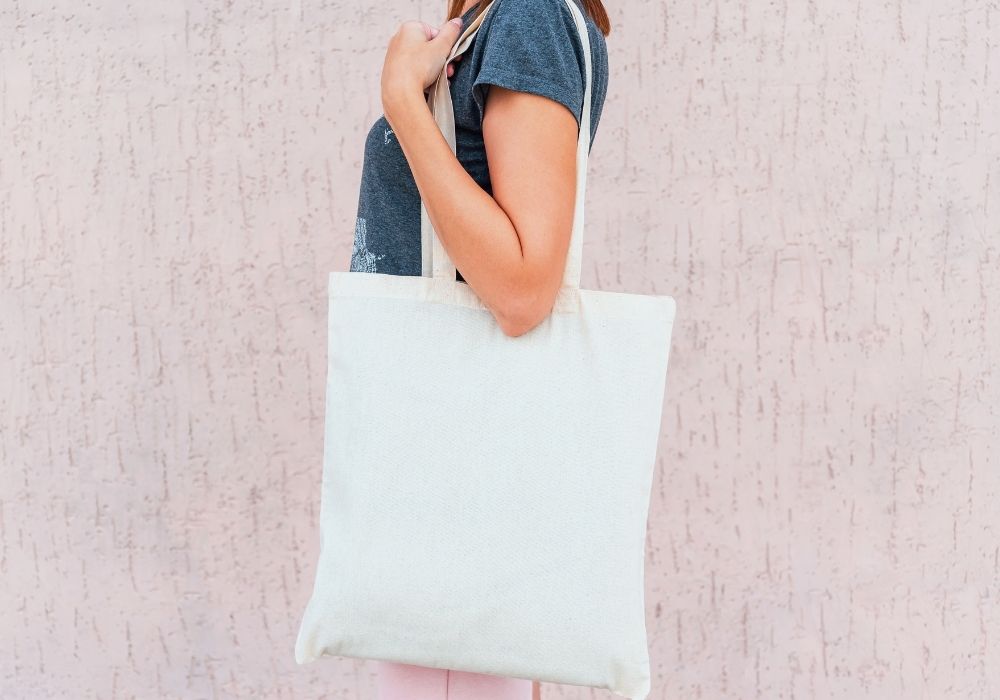
Thara
Sunday 17th of March 2024
Heya.
There are a ton of tried and tested ways in order to save money. For example you can go to Poundland to find cheap goods. Or you can buy a lot of other stuff at local farm shops in the garden centres in question here and online too. Often times it is a good idea to visit a few different local charity shops to find new party clothes, storybooks and so on. Good luck. You can surely do this. Hugs. Control your own family finances. Have a weekly spreadsheet to describe the state of finances.
Alternatively you can discover items at table top and church sales. Otherwise start at libraries and community centres to find more new things. Another fun and cheaper option is to try to hire things directly. You can even see if there are discounts or deals available as well. You can scout out free stuff. Make full use of freebies. Try to think outside the box in addition to discover other new options. Get tailored recommendations. Be totally original. Read beyond the lines. Never lie though.
Prepare and use colourful numbered lists. Write down some brief short and summary notes. Cast the net wide. You will surely have a lot of better results that way for sure. Be very smart at all times. Instead of eating out either have a take away or cook from nothing at home. Do your own research online first of all. Call to confirm things on the telephone or send a friendly query via email in advance. That is truly the best way to get up to date information, make it a good habit to do so every time you book things.
Double verify all things. Never miss a beat. You can buy things via a newspaper these days on top of that. Also farming markets provide fruit at rock bottom costs each week in my area. Find a community book swap. Ask at your nearest church in any case. My hometown has a weekly farming market at which they sell on fresh produce to people. Check the store prices carefully. Smile.
Mainly this is fresh meat, fruit or veg. Failing that you can drive to pick your own farms for more fresh meat, fruit or veg these days. They can sell you a lot of clean and nice fruit. Pay a leisurely visit to such places. Take a empty box with you to collect the fresh fruit or veg. There are also the subscription boxes yet I’m not sure about the item quality. I have not trialled any of those at all. Bulk order and purchase. Know the return policy of the store.
And I’m not sure if I would care for such things. If your friend or relative owns a allotment you can get a hold of free and fresh fruit easily. Same applies to finding fresh meat on the cheap. Literally all goods can be purchased for next to nothing if you are prepared to hunt around near and far. When it comes to buying pricey things read the total number of positive or negative reviews online. This is crucial. Obtain stationary on the cheap.
All you need to do is to take a good look. Make solid plans. Think carefully about purchasing items online. Check everything twice over. Discuss reasons. Do your final calculations well.
Balance Through Simplicity
Tuesday 19th of March 2024
Hi Thara, thank you for sharing your thoughts and ideas. These are great and really helpful!
Nancy Carroll
Wednesday 24th of January 2024
The "sit on it" tip is my biggest hack!! im a HUGE impulse buyer, but if i leave it in my cart for a day or if in a store, leave it on the shelf and think about it until im ready to check out, 9 out of 10 times i wont buy the item :)
Balance Through Simplicity
Thursday 25th of January 2024
Hi Nancy. Thank you for that. Yes! I do this too. I find it gives me time to see if I've got something else that will do instead or whether I really, really need it as much as I think I do!
Laura
Sunday 19th of November 2023
I do most of my shopping online these days, and while it can be great, it's also awfully easy at times to click those buttons and buy, because it's slightly removed from the reality of a store purchase. So I add things to my wishlists and leave them, to see if I still want them later. That often satisfies my need to shop, somehow, as well. I'm often grateful for this trick when I go back to my wishlist, and realize that I don't actually want those items at all!
Some online stores don't have wishlists, so I leave items in my basket for 24 hours. If I still want the item, I'll buy it. If not, I go back and empty my basket so that I don't tie up the retailer's merchandise.
Lastly, right now I'm saving up to move, so that's a good reminder when I'm browsing online. I tell myself I'll buy it after I've moved. As you've said before, Antonia, knowing why you're doing something can make all the difference! Thanks for all the great tips.
Balance Through Simplicity
Sunday 19th of November 2023
Hi Laura, thank you for reading and for your sharing your helpful tips too. It just goes to show that our love of shopping is driven by so much more than just wanting more stuff. Thank you.